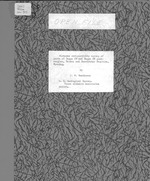The accompanying map shows the results of an airborne radioactivity survey in 151 square miles of Baggs SW and Baggs SE quadrangles, Wyoming. This area is part of a larger survey made in southern Carbon and Sweetwater counties by the U.S. Geological Survey, November 9-24, 1953. The work was undertaken as part of a cooperative program with the U.S. Atomic Energy Commission. The survey was made with scintillation detection equipment mounted in a C-47 aircraft and consisted of parallel east-west flight lines spaced at quarter mile intervals, flown approximately 500 feet above the ground. Aerial photographs were used for pilot guidance, and the flight path of the aircraft was recorded by a gyrostabilized, continuous-strip-film camera. The distance of the aircraft from the ground was measured with a continuously recording radio altimeter. The width of the zone on the ground form which the anomalous radiation is measured at the nominal 500 foot flight altitude varied with the areal extent and the intensity of radioactivity of the source. For strong sources of radioactivity the width of the zone may be as much as 1,400 feet. Thus, quarter mile spacing of the flight lines would be adequate to detect anomalies from strong sources of radioactivity; however, small areas of considerable radioactivity midway between flight lines may not be noted. The approximate locations of twelve radioactivity anomalies are shown on the accompanying map. The plotted position of the anomalies may be in error by as much as a quarter mile owing to the errors in available base maps or to the existence of areas on the base maps up to several square miles in which it is impossible to find and plot recognizable landmarks. The present technique of airborne radioactivity measurement does not permit distinguishing between activity due to thorium and that due to uranium. An anomaly, therefore, may represent radioactivity due entirely to one or to a combination of these elements. The radioactivity anomalies shown on the accompanying map cannot be interpreted in terms of either radioactive content or the extent of the source materials. Any particular anomaly may represent slightly greater-than-average radioactivity over an area of a few thousand square feet or high radioactivity over an area of a few hundred square feet. Thus radioactivity anomalies indicate localities of more-than-average radioactivity and, therefore, suggest areas in which uranium or thorium deposits are more likely to occur.


